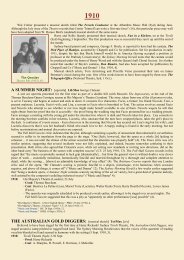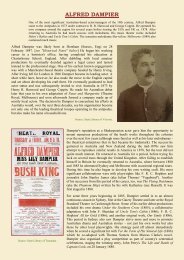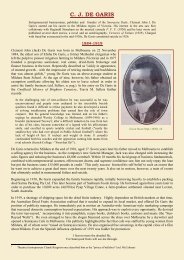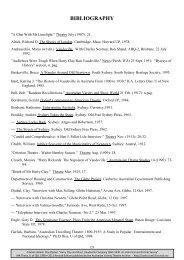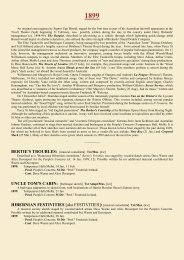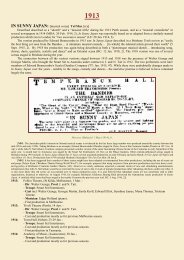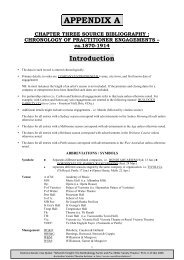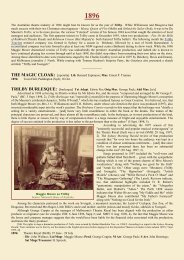GEORGE WALLACE - Australian Variety Theatre Archive
GEORGE WALLACE - Australian Variety Theatre Archive
GEORGE WALLACE - Australian Variety Theatre Archive
You also want an ePaper? Increase the reach of your titles
YUMPU automatically turns print PDFs into web optimized ePapers that Google loves.
1929-1939<br />
By 1929, Wallace's troupe included such well-known variety performers as Jim Romaine (ex-Drew and Romaine) and husbandand-wife<br />
comedy sketch artists Bert Dudley and Evelyn Dudley. There appears to have been no reduction in interest in the<br />
company, despite the rising popularity of film. Reports indicate, for example, that their New Zealand tour of 1929 was still pulling<br />
capacity crowds fifteen weeks after it commenced. Shortly after concluding a fifteen-week season at the Melbourne Tivoli in early<br />
1930 (possibly his first non-Fullers' engagement since joining the firm in 1924), Wallace undertook a tour of the west, playing<br />
Adelaide, Perth and the West <strong>Australian</strong> goldfields through until possibly January 1931. He then travelled to England for a<br />
month's holiday before opening a season on the London variety stage, reportedly on a contract of £150 a week (E: 2 Apr. 1930,<br />
41). The shows were staged with two or three members of his <strong>Australian</strong> troupe, while the rest of the ensemble comprised<br />
performers engaged in London. However, without the support of his regular company, and with a comic delivery that may well<br />
have been too casual for the British, Wallace failed to ignite enough interest to remain there for very long. A bitterly cold winter<br />
forced his hand and he returned to Australia soon afterwards. In retrospect, it was an important decision, because the 1930s saw<br />
his career branch out successfully into film and full-scale musical comedy.<br />
Wallace's film career began in 1932, when Frank Thring signed him to Efftee Films and produce and adapt one of his most<br />
popular revusicals, His Royal Highness. Despite Thring's heavy-handed direction, the film became a critical and commercial<br />
success around the country. In reviewing the Queensland premiere, the Brisbane Courier's film critic typified the critical response<br />
to Wallace's performance:<br />
His Royal Highness is aptly described as a comedy with music as distinct from a musical comedy. The comedy is there in full<br />
measure, and although the few musical numbers introduced are tuneful they are not the essential features. The fun is almost<br />
exclusively created by George Wallace... [his] facility of expression and his whimsical drolleries, as well as clever dancing,<br />
eminently lend themselves to the screen work (3 Oct. 1932, 15).<br />
While agreeing that Wallace dominated the film (and that his comic talent was unquestioned), the Age's film critic suggested that<br />
such a dominance was part of the overall weakness of the film, as were the frequent shots in which parts of the performers' heads<br />
were lost from view (31 Oct. 1932, 8).<br />
In between his film commitments, Wallace continued to take on stage work. In 1933, for example, he accepted a cameo role in the<br />
stage musical Collits' Inn, while also contributing additional material to the libretto (including some lyrics). Although his<br />
performance as Dandy Dick was roundly applauded by audiences, at least one critic found his antics inappropriate at times and<br />
suggested that he would be more effective if he kept within his part (TBT: 28 Dec. 1933, 14). Wallace's long-time onstage partner,<br />
Marshall Crosby, was also engaged for the production (taking on the role of Pierce Collits, owner of the inn and father of the<br />
heroine, Mary). Comedian/actor John V. Dobbie, who later starred opposite Wallace in several of his films, was also in the cast.<br />
The second of Wallace's films, Harmony Row, was released in 1933, attracting similar plaudits to the first. Costing £11,000<br />
pounds, it also co-starred several members of his old revusical troupe, notably Marshall Crosby and Nell Fleming, along with<br />
well-known ex-pantomime dame Dan Thomas.<br />
Courier Mail 18 Aug. (1939), 21.<br />
In 1934, Wallace again returned to the stage, appearing as one of the<br />
principals in the Dudley Glass musical The Beloved Vagabond. Following<br />
the <strong>Australian</strong> debut in Melbourne, the Argus theatre critic wrote of<br />
Wallace's performance: "[His] Asticot is an amusing fellow - a curious<br />
blending of Australia and Montmartre, if such a fusion is comprehensible. He<br />
is adapting himself quickly and successfully to the requirements of the<br />
musical comedy stage, which is of course very difficult from the variety<br />
stage. His best number is 'Napoleon the Oneth'" (23 Apr. 1934, 12). The Age<br />
critic similarly notes the incongruous nature of Wallace's acting and the<br />
brilliance of his burlesque work in the Napoleon scene (16 Apr. 1934, 12).<br />
The Sydney season, staged later in August, saw the Sydney Morning Herald<br />
report that the comedian had never been funnier, particularly in the Paris<br />
roof-tops scene. "[It] introduced some of Mr Wallace's cleverest fooling,"<br />
wrote the paper's theatre critic. "The incident in which he represented<br />
Napoleon, with Mr John Dobbie as Wellington, was densely packed with<br />
comic ingenuity. Like Miss Moncrieff Mr Wallace has achieved greater<br />
success by being more reposeful and natural, and giving up a too obvious<br />
repertoire of stage tricks and stage inflections" (25 Aug. 1934, 16).<br />
Although Wallace continued to appear on the stage throughout the 1930s, his<br />
career during that decade is chiefly remembered for the films he starred in. A<br />
Ticket in Tatts (1934), his final Efftee production, saw him cast as a disasterprone<br />
stable hand whose whistle can make one of the horses run faster. He<br />
was slated to appear alongside Frank Harvey, Claude Fleming, and Campbell<br />
Copelin in another Thring film, Sheepmates (based on the novel by the same<br />
name, by William Hatfield), but although a few scenes were shot on a cattle<br />
station in Central Australia in late 1934, the film was never completed<br />
(Celluloid Heroes CD-Rom 1996, 1930-1939, 18).




